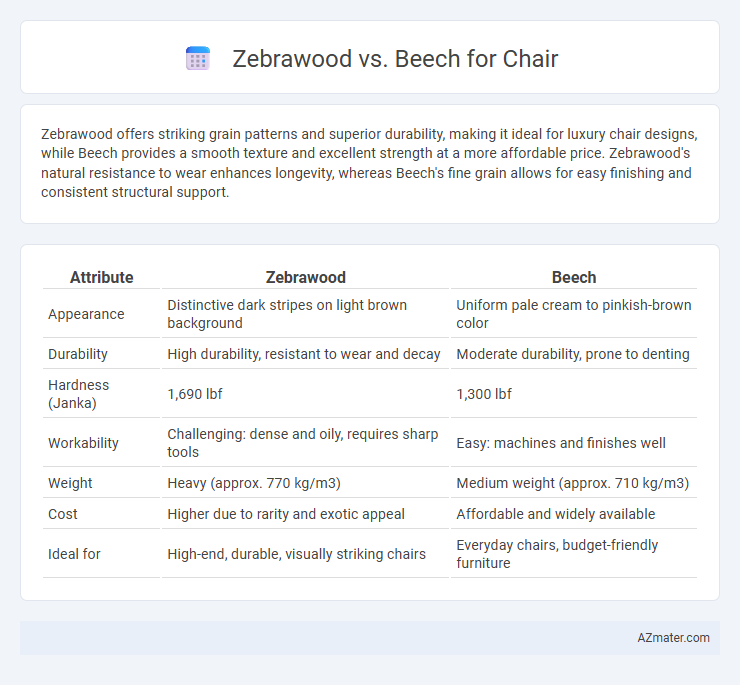Zebrawood offers striking grain patterns and superior durability, making it ideal for luxury chair designs, while Beech provides a smooth texture and excellent strength at a more affordable price. Zebrawood's natural resistance to wear enhances longevity, whereas Beech's fine grain allows for easy finishing and consistent structural support.
Table of Comparison
| Attribute | Zebrawood | Beech |
|---|---|---|
| Appearance | Distinctive dark stripes on light brown background | Uniform pale cream to pinkish-brown color |
| Durability | High durability, resistant to wear and decay | Moderate durability, prone to denting |
| Hardness (Janka) | 1,690 lbf | 1,300 lbf |
| Workability | Challenging: dense and oily, requires sharp tools | Easy: machines and finishes well |
| Weight | Heavy (approx. 770 kg/m3) | Medium weight (approx. 710 kg/m3) |
| Cost | Higher due to rarity and exotic appeal | Affordable and widely available |
| Ideal for | High-end, durable, visually striking chairs | Everyday chairs, budget-friendly furniture |
Introduction to Zebrawood and Beech
Zebrawood is a hardwood known for its distinctive dark brown stripes on a light tan background, offering exceptional durability and a bold aesthetic ideal for chair construction. Beech, a pale, fine-grained hardwood, provides excellent strength and smooth finish, making it a popular choice for ergonomic and lightweight chair designs. Both woods offer unique visual and structural qualities that influence chair style and longevity.
Origin and Availability
Zebrawood, native to West Africa, is known for its distinctive dark stripes on a pale background and is relatively rare due to limited regional growth and sustainable harvesting practices. Beech, primarily found in Europe, North America, and parts of Asia, is widely available and commonly used in chair manufacturing for its consistent grain and ease of sourcing. The availability of beech wood makes it a more economical and accessible option compared to the exotic and pricier zebrawood.
Physical Appearance and Grain Patterns
Zebrawood features striking, bold dark stripes on a light golden-yellow to medium brown background, creating a dramatic striped grain pattern that enhances chair aesthetics with a unique, exotic appeal. Beech displays a fine, straight grain with a uniform, pale cream to light reddish-brown color, offering a more subtle and consistent appearance suitable for classic or modern chair designs. The distinct grain patterns in Zebrawood make each chair visually dynamic, while Beech's smooth texture and understated look provide timeless elegance and versatility.
Hardness and Durability Comparison
Zebrawood exhibits a Janka hardness of approximately 1,290 lbf, making it significantly harder than Beech, which has a Janka rating near 1,300 lbf but is generally considered softer in practical applications due to its grain structure. The dense, interlocking grain of Zebrawood enhances its resistance to dents and wear, contributing to superior durability in high-traffic furniture like chairs. Beech, while moderately hard and resilient, tends to be more susceptible to dents and scratches over time, making Zebrawood a preferred choice for long-lasting, durable seating solutions.
Workability and Ease of Shaping
Zebrawood offers moderate workability with its interlocked grain, which can cause some difficulty in shaping and may require sharp tools and careful handling to avoid tear-out. Beech is highly regarded for its excellent workability and ease of shaping, thanks to its even texture and straight grain, making it ideal for detailed chair components and smooth finishes. Both woods perform well in chair construction, but beech is generally preferred for projects demanding precision and efficient machining.
Comfort and Ergonomics in Chairs
Zebrawood chairs offer a unique blend of durability and natural flexibility, contributing to ergonomic support by contouring to body shapes more effectively than denser hardwoods like Beech. Beech wood, known for its smooth finish and consistent grain, provides firm, stable seating surfaces that promote proper posture and long-term comfort. When prioritizing comfort and ergonomics, Zebrawood's resilience may enhance dynamic sitting experiences, while Beech's rigidity supports structured design for optimal spinal alignment.
Cost and Affordability
Zebrawood is significantly more expensive than beech due to its exotic status and limited availability, making it a premium choice for chair manufacturing. Beech offers excellent affordability with consistent strength and workability, often favored in mass production for cost-effective furniture. When budget constraints are critical, beech provides a reliable, economical option without compromising durability.
Environmental Impact and Sustainability
Zebrawood, harvested from West African forests, is less sustainable due to slower growth rates and risks of deforestation, while beech wood, primarily sourced from European plantations, offers a more renewable and eco-friendly option due to faster growth and efficient forest management practices. Beech's ability to be sourced from sustainably managed forests with certifications like FSC (Forest Stewardship Council) enhances its environmental profile for chair manufacturing. Zebrawood's exotic appeal comes with higher carbon footprint concerns, making beech a preferable choice for eco-conscious furniture production.
Best Uses: Style and Interior Design
Zebrawood's bold, striped grain offers a striking, exotic aesthetic ideal for statement chairs in modern, eclectic, or tropical-inspired interiors, adding visual drama and texture. Beech features a smooth, light grain with a warm, neutral tone, making it versatile for chairs in minimalist, Scandinavian, or traditional settings where subtle elegance and durability are essential. Both woods provide strong structural support, but Zebrawood excels in creating focal points, while Beech suits functional, understated furniture designs.
Conclusion: Choosing Between Zebrawood and Beech
Zebrawood offers a striking, exotic appearance and exceptional durability, making it ideal for high-end, statement chairs requiring unique aesthetics and long-lasting strength. Beech, with its fine grain, light color, and excellent workability, suits traditional chairs that prioritize comfort, affordability, and ease of craftsmanship. Selecting between Zebrawood and Beech depends on balancing visual impact and budget with functional needs and style preferences.

Infographic: Zebrawood vs Beech for Chair
 azmater.com
azmater.com